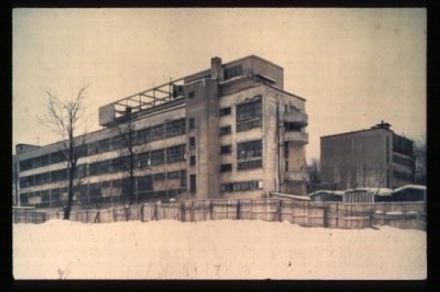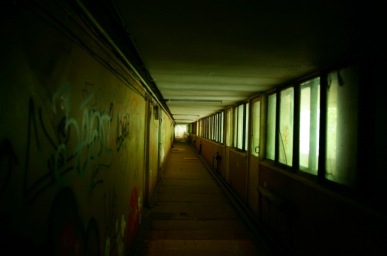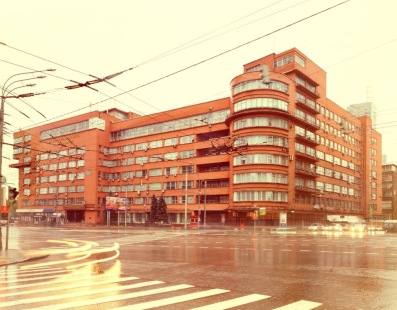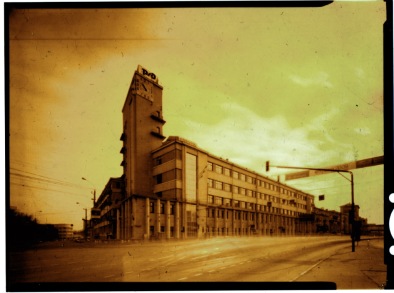[From Modern Architecture, 1926 (no. 1, pgs. 1-4)]
[Pg. 1]
One decade separates us from the architectural “affluence” of the pre-Revolutionary era, when in Petersburg, Moscow, and other great centers the best Russian architects lightheartedly cultivated every possible “style.”
Is a decade so much?
It is a small fissure in time. But the Revolution, in sweeping away the stagnant prejudices and outlived canons, has turned the fissure into an abyss. On the far side of that abyss remain the last witherings of the already decrepit system of European thinking, of that unprincipled eclecticism which always has a thousand aesthetic recipes at the ready, all of them approved by our grandfathers and great-grandfathers. Such thinking was ready to ladle out truth from wherever suited — provided it was from a source in the past.
On this side of the abyss is opening up a new path which still has to be paved, and great new expanses of space which still have to be developed and populated. The outlook and worldview of the contemporary architect is being forged in the circumstances of today and new methods of architectural thinking are being created.
Instead of the old system in architectural designing, where the plan, construction, and external treatment of the building were in a state of constant antagonism, and where the architect had to use his powers to the full as peacemaker in irreconcilable conflicts of interest, the new architectural work is characterized above all by its single indivisible aim and aspiration. It is a process in which the task is hammered out logically and which represents a consciously creative [sozidatel’ny] process from beginning to end.
In place of the abstracted and extremely individualistic inspiration of the old-style architect, the contemporary architect is firmly convinced that the architectural task, like any other, can only be solved through a precise elucidation of the factors involved [the “unknownsâ€] and by pursuing the correct method of solution.
The architect sees around him the fearless creativity of inventors in various fields of contemporary technology, as with gigantic steps it conquers the earth, the ocean depths, and the air, winning new bridgeheads by the hour. It is not difficult to see that these astonishing successes of human genius are explained, in general, by the fact that the right method was pursued in tackling the task. The inventor knows full well that however energetic the upsurge of his creative enthusiasm may be, it wil be useless without a sober consideration of all the minutiae in the circumstances surrounding his activity. He is fully armed with contemporary knowledge. He takes account of all the conditions of today. He conquers the future.
Certainly it would be naïve to replace the complex art of architecture by an imitation of even the [Pg. 2] most sparkling forms of contemporary technology. This period of naïve “machine symbolism†is already outdated. In this field it is only the inventor’s creative method that the contemporary architect must master. Any mould or model from the past must be categorically repudiated, however beautiful it may be, for the pursuits of the architect are in their essence precisely such invention, just like all other invention. His is a work of invention which has set itself the aim of organizing and constructing a concrete practical task not just in response to the dictates of today but as something that will serve the needs of tomorrow.

Original model of the Vesnin brothers’ proposal for the Leningrad Pravda building
Thus first and foremost we face the question of clearly exposing all the unknowns of the problem. First among these are the unknowns of a general charcter, dictated by our epoch as a whole. Here we are identifying those particular features of the problem which derive from the emergence of a new social consumer of architecture — the class of workers, who are organizing not only their own contemporary way of life but also the complex forms of new economic life of the State. It is not a question of adapting to the individual tastes of this new consumer. Unfortunately, in posing the problem it is often reduced to precisely this, and people hastily try to attribute to worker tastes and preferences which are essentially echoes of old pre-revolutionary attitudes.
Least of all is it a matter of tastes here at all. What we are concerned with is elucidating the characteristics of the new consumer, as a powerful collective which is building a socialist state.
It is a question, above all, of the principle of plannedness. This must not just be a feature of the way leading state organs operate, but must become part of the work of every architect. It is how the solving of individual problems becomes part of the larger productive network of the country as a whole.
The character of a contemporary architect’s work is radically altered by the fact that he recognizes his activity to be the establishing of architectural standards for the organization of new dwellings and towns, rather than the fulfillment of individual commissions. He sees it as his task to be continually advancing and improving those standards, in connection with the larger characteristics of production and with the advancing technological levels both here and internationally. In the conditions through which we are living as we develop socialism, each new solution by the architect, be it a dwelling block, a workers’ club, or a factory, is conceived by us as the invention of a more advanced model or type, which answers the demands of its brief and is suitable for multiple production in whatever quantities the needs of the state require. From the very start, this situation diverts the architect’s energy away from the pursuit of a solution answering individual tastes, and redirects it towards further improvement of the standard type which he has devised, and a fuller, more sophisticated standardization of its details. But in order that these type-solutions may undergo a genuinely radical renewal, they must derive from the new principles of a rational urbanism which will satisfy tomorrow’s needs as well as today’s. It is thus obvious that the conditions of our State will authoritatively throw us from the single architectural unit, through a complicated manufacturing process, to the whole complex, the village, the township, and the city.

Sketch of the Vesnins’ Leningrad Pravda Building (1924)
Unfortunately, the specialists at the head of those state organs in charge of our building are the ones least concerned about this important issue, who are least of all inclined to keenly look ahead. They [Pg. 3] are quite satisfied, for example, that construction in the largest center of the USSR — Moscow — is limited to four-or six-storey buildings.
It is needless to say that for smaller cities or housing estates these are nothing better than garden cities [goroda-sada], with their small mansions, courtyards, and flower-gardens, and yet no one seems to have this on his mind. But meanwhile this Howardian [Ebenezer Howard — RW] ideal has lagged behind modernity for no less than ten years (and also behind our Soviet modernity for an even more substantial period of time)?
In order for a modern architect to deal with such anachronisms, the greater is his need to fight on two fronts: [1] the elaboration of new, rational principles for the planning of architecture for the aggregate population [naselennykh mest] and [2] the creation of standards that would serve as a prerequisite for the foundation of a new, more prudent image of the city.
The social conditions of our modern world are such that questions of individual aesthetic developments in architecture arise only secondarily. Today’s conditions focus our attention first and foremost onto the problem of rational new types in architecture, and by including the architect within the overall production chain of the country, they abolish the isolation which previously existed between various forms of architectural and engineering activity. Certainly the complex development of our life is such that more than at any other time, it compels the architect to specialize in a specific field, but at the same time the firm conviction that has arisen amongst all contemporary architects that their different specialties — housing, community buildings, factories — are merely subsections of a homogeneous territory [ubezhdenie v odno-znachnosti ikh tvorchekoi deiate’nosti].  So some are busy creating a new type of housing, others with the development of new public facilities, and still others with the building of a new factory or plant.  And precisely because construction possessing a factory/industrial or engineering character was never firmly linked to the stagnant traditional art of the past, [the engineers] found that the principles underlying their mode of creation were much more responsive to the needs the time, and better suited to the serving of a new life. As a result, not only has the boundary between engineering structures and public architecture been wiped out of our thinking, but those very engineering structures themselves have come to be seen as front-line pioneers in the shaping of a genuinely contemporary architecture.
Sober calculation of all these circumstances, which have been created and intensified by our present social conditions, is not just the first condition for a correct solution of our architectural tasks. It is also the source of all those purely architectural possibilities which lie concealed within the changes which have taken place in our mode of life.
But alongside these, there is a series of other “unknowns†facing the architect, which derive quite separately from the particularities of each factor of the given piece of work, from the particular features of the task in hand, from its functional requirements and from the productive and locational conditions obtaining in that situation.
The solving of these ‘unknowns’ leads to an entirely new method of architectural thinking: to the method of functional design.
Free from the handed-down models of the past, from prejudices and biases, the new architect analyzes all sides of his task, all its special features. He dismembers it into its component elements, groups them according to functions and organizes his solution on the basis of these factors. The result is a spatial solution which can be likened to any other kind of rationally conceived [razumnyi] organism, which is divided into individual organs that have been developed in response to the functional roles which each fulfills.
As a result of this we are seeing in the works of contemporary architects the emergence of entirely new types of plan. These are generally asymmetrical, since it is extremely rare for functional parts of a building to be absolutely identical. They are predominantly open and free in their configurations, because this not only better bathes each part of the building in fresh air and sunlight, but makes its functional elements more clearly readable and makes it easier to perceive the dynamic life that is unfolding within the building’s spaces.
That same method of functional creativity leads not only to clear calculation of the ‘unknowns’ of the task, but to an equally clear calculation of the elements of its solution.
The architect then arranges [ustanavlivaet] the main path to the secondary in his work, from the core to the outer shell. Only functional architectural thinking establishes [ustanavlivaet] the spatial organization firmly as the starting point of the work, indicating the place at which the bulk of the impact should be directed.  Thus, the determination [ustanovlenie] of the specific conditions of the job — the number of individual spatial variables, their dimensions and mutual connection — emerges as the primary function. From this first point alone does the modern architect proceed; it is this that compels him to unfold his plan from the inside out, rather than vice versa, as was done during the period of eclecticism.   This directs his entire future path.
The second moment for the architect becomes the framing from within of the spatial problem or from a particular material and one or another methods of construction. Â It is clear that this is an inevitable function of the baseline spatial resolution.
The next stage in the work of the new architect is the ratio of the spatial volume of the outside, a grouping of architectural masses.  Their rhythm and proportions follow naturally from the first half of the architect’s activity — they stand as a function of the constructive material of the exterior and its hidden spaces.
[Pg. 4]
And finally, there is the interpretation of some wall surfaces and the design of individual — elements, holes, poles, etc. — all the functions of some of these, or any other extraneous data.
Thus the very method of functional creativity leads us to a unified organic creative process where one task leads from another with all the logic of a natural development, instead of the old-style chopping up into separate independent tasks which are usually in conflict with each other. There is no one element, no one part of the architect’s thinking which would be arbitrary. Everything would find its explanation and functional justification in its suitability for a purpose. The whole unifies everything, establishes equilibrium between everything, creates images of the highest expressiveness, legibility, and clarity, where nothing can be arbitrarily changed.
In place of the ready-made models of the past which have been chewed over endlessly, the new method radically re-equips the architect. It gives him a healthy direction to his thiking, inevitably leading him from the main factors to the secondary ones. It forces him to throw out what is unnecessary and to seek artistic expressiveness in that which is most important and necessary.
There is absolutely no danger in the asceticism of the new architecture which emerges from this method. It is the asceticism of youth and health. It is the robust asceticism of the builders and organizers of a new life.
[Из Современной архитектуры 1926 (No. 1, pgs. 1-4)]
Одно деÑÑтилетие отделÑет Ð½Ð°Ñ Ð¾Ñ‚ архитектурного «благополучиÑ» довоенного времени, когда в Ленинграде, МоÑкве и других крупных центрах лучшие руÑÑкие зодчие беззаботно наÑаждали вÑевозможные «Ñтили».
Много ли деÑÑтилетие?
ÐœÐ°Ð»ÐµÐ½ÑŒÐºÐ°Ñ Ñ‚Ñ€ÐµÑ‰Ð¸Ð½ÐºÐ° времени. Ðо революциÑ, уничтожив коÑные предраÑÑудки и отжившие каноны, превратила трещинку в пропаÑÑ‚ÑŒ. По ту Ñторону пропаÑти оÑталÑÑ Ð¿Ð¾Ñледний Ñтап увÑÐ´Ð°Ð½Ð¸Ñ Ð¾Ð´Ñ€Ñхлевшей ÑиÑтемы европейÑкого мышлениÑ, беÑпринципный Ñклектизм, имеющий наготове Ñ‚Ñ‹ÑÑчу художеÑтвенных рецептов, апробованных нашими дедами и прадедами, готовый черпать иÑтину откуда угодно, — но только в прошлом.
По Ñту Ñторону открываетÑÑ Ð½Ð¾Ð²Ñ‹Ð¹ путь, который еще надо прокладывать, новые проÑторы, которые нужно еще заÑелить. Ð’ обÑтановке ÑегоднÑшнего Ð´Ð½Ñ ÐºÑƒÐµÑ‚ÑÑ Ð¼Ð¸Ñ€Ð¾Ñозерцание Ñовременного зодчего, ÑоздаютÑÑ Ð½Ð¾Ð²Ñ‹Ðµ методы архитектурного мышлениÑ.
ВмеÑто Ñтарой ÑиÑтемы архитектурного творчеÑтва, где план, конÑÑ‚Ñ€ÑƒÐºÑ†Ð¸Ñ Ð¸ внешнее оформление Ð·Ð°Ð´Ð°Ð½Ð¸Ñ Ð¿Ð¾ÑтоÑнно находилиÑÑŒ во взаимной вражде и где архитектор был по мере Ñил Ñвоих примирителем вÑех Ñтих неразрешимых конфликтов, — новое архитектурное творчеÑтво, прежде вÑего, характеризуетÑÑ Ñвоим единым нераздельным целевым уÑтремлением, в котором органичеÑки выковываетÑÑ Ð·Ð°Ð´Ð°Ñ‡Ð° и к которому ÑводитÑÑ Ñозидательный процеÑÑ Ð¾Ñ‚ начала до конца.
ВмеÑто отвлеченного и крайне индивидуалиÑтичеÑкого Ð²Ð´Ð¾Ñ…Ð½Ð¾Ð²ÐµÐ½Ð¸Ñ Ñтарого архитектора — Ñовременный зодчий твердо убежден в том, что Ð°Ñ€Ñ…Ð¸Ñ‚ÐµÐºÑ‚ÑƒÑ€Ð½Ð°Ñ Ð·Ð°Ð´Ð°Ñ‡Ð° решаетÑÑ, как и вÑÑÐºÐ°Ñ Ð¸Ð½Ð°Ñ, лишь в результате точного выÑÑнениÑне извеÑтных и отыÑÐºÐ°Ð½Ð¸Ñ Ð¿Ñ€Ð°Ð²Ð¸Ð»ÑŒÐ½Ð¾Ð³Ð¾ метода решениÑ.
Зодчий видит вокруг ÑÐµÐ±Ñ Ñмелое творчеÑтво Ð¸Ð·Ð¾Ð±Ñ€ÐµÑ‚Ð°Ñ‚ÐµÐ»Ñ Ð² разных облаÑÑ‚ÑÑ… Ñовременной техники, гигантÑкими шагами побеждающей землю, недра и воздух, Ñ ÐºÐ°Ð¶Ð´Ñ‹Ð¼ чаÑом отвоевывающей вÑе новые и новые позиции. Ðе трудно понÑÑ‚ÑŒ, что Ñтот изумительным уÑпех человечеÑкого Ð³ÐµÐ½Ð¸Ñ Ð¾Ð±ÑŠÑÑнÑетÑÑ, главным образом, правильным методом творчеÑтва. Изобретатель твердо знает, что как бы ни был Ñрок подъем его творчеÑкого Ñнтузиазма — он будет беÑцелен без трезвого учета мельчайших обÑтоÑтельÑтв, окружающих его деÑтельноÑÑ‚ÑŒ. Он во вÑеоружии Ñовременного знаниÑ, он учитывает вÑе уÑÐ»Ð¾Ð²Ð¸Ñ ÑегоднÑшнего днÑ, он Ñмотрит вперед завоевывает будущее.
Конечно, наивно было бы подменить Ñложное иÑкуÑÑтво архитектуры подражанием тем или иным, Ñ…Ð¾Ñ‚Ñ Ð±Ñ‹ [Pg. 2] Ñамым блеÑÑ‚Ñщим формам Ñовременной техники. Ðтот период наивного «машинного Ñимволизма» уже изжит. Лишь творчеÑкий метод Ð¸Ð·Ð¾Ð±Ñ€ÐµÑ‚Ð°Ñ‚ÐµÐ»Ñ Ð´Ð¾Ð»Ð¶ÐµÐ½ быть завоеван Ñовременным архитектором. Должно быть категоричеÑки отвергнуто наличие каких-либо штампов прошлого, как бы прекраÑно оно ни было, ибо иÑÐºÐ°Ð½Ð¸Ñ Ð·Ð¾Ð´Ñ‡ÐµÐ³Ð¾ по ÑущеÑтву Ñвоему такое же изобретение, как и вÑÑкое другое, изобретение, ÑтавÑщее Ñебе целью организовать и ÑконÑтруировать конкретную практичеÑкую задачу, не только диктуемую ÑегоднÑшним днем, но и пригодную Ð´Ð»Ñ Ð·Ð°Ð²Ñ‚Ñ€Ð°ÑˆÐ½ÐµÐ³Ð¾.
Итак, прежде вÑего, ÑÑное раÑкрытие вÑех неизвеÑтных. И, в первую очередь, неизвеÑтных общего характера, диктуемых нашей Ñпохой в целом, раÑкрытие оÑобенноÑтей, ÑвÑзанных Ñ Ð¿Ð¾Ñвлением нового Ñоциального Ð¿Ð¾Ñ‚Ñ€ÐµÐ±Ð¸Ñ‚ÐµÐ»Ñ Ð°Ñ€Ñ…Ð¸Ñ‚ÐµÐºÑ‚ÑƒÑ€Ñ‹ — клаÑÑа трудÑщихÑÑ, организующего не только Ñвой Ñовременный быт, но и Ñложные формы новой хозÑйÑтвенной жизни гоÑударÑтва. Тут, конечно, речь идет не о подлаживании к индивидуальным вкуÑам нового потребителÑ. К Ñожалению, чаÑто именно к Ñтому ÑводÑÑ‚ поÑтановку вопроÑа, при чем еще ÑтараютÑÑ Ð¿Ð¾Ñпешно припиÑать рабочему вкуÑÑ‹ и вкуÑики, ÑвлÑющиеÑÑ Ð¿Ð¾ ÑущеÑтву отголоÑком Ñтарых дореволюционных взглÑдов.
Ðо тут дело меньше вÑего заключаетÑÑ Ð²Ð¾ вкуÑах. Речь идет о выÑÑнении оÑобенноÑтей нового потребителÑ, как мощного коллектива, ÑтроÑщего ÑоциалиÑтичеÑкое гоÑударÑтво.
Речь идет, прежде вÑего, о принципе плановоÑти, который должен войти в работу не только тех или иных руководÑщих гоÑударÑтвенных органов, но и в работу каждого зодчего, о включении отдельных замыÑлов в общую производÑтвенную Ñеть вÑей Ñтраны.
Коренным образом менÑет характер работы Ñовременного архитектора то, что он Ñознает Ñвою деÑтельноÑÑ‚ÑŒ не как выполнение отдельных заказов, а как уÑтановку Ñтандартов архитектуры, организующих новые жилища и города, как непрерывное ÑовершенÑтвование Ñтих Ñтандартов, в ÑвÑзи Ñ Ð¾Ð±Ñ‰Ð¸Ð¼Ð¸ производÑтвенными оÑобенноÑÑ‚Ñми, Ñ ÑƒÑ€Ð¾Ð²Ð½ÐµÐ¼ нашей и международной Ñтроительной техники. Ð’ уÑловиÑÑ… переживаемого нами ÑтроительÑтва Ñоциализма, каждое новое решение архитектора — жилой дом, клуб, фабрика — мыÑлитÑÑ Ð½Ð°Ð¼, как изобретение Ñовершенного типа, отвечающего Ñвоей задаче и пригодного к размножению в любом количеÑтве, Ñообразно Ñ Ð¿Ð¾Ñ‚Ñ€ÐµÐ±Ð½Ð¾ÑÑ‚Ñми гоÑударÑтва. Ðто обÑтоÑтельÑтво заранее отводит Ñнергию архитектора от поиÑков индивидуально-вкуÑового Ñ€ÐµÑˆÐµÐ½Ð¸Ñ â€” к ÑовершенÑтвованию Ñвоего Ñтандарта, к уточнению и макÑимальной типизации вÑех его деталей. Ðо Ð´Ð»Ñ Ñ‚Ð¾Ð³Ð¾, чтобы Ñти Ñтандарты были дейÑтвительно радикально обновлены, Ð´Ð»Ñ Ñ‚Ð¾Ð³Ð¾, чтобы они Ñтали подлинно новыми архитектурными произведениÑми, конечно, они должны быть задуманы не на индивидуальном учаÑтке, не произвольной прихотью, не в теÑных рамках Ñкученного и Ñлучайно планированного города, а обратно, иÑходить из общего целого, из новых принципов рационального урбанизма, пригодного и Ð´Ð»Ñ Ð·Ð°Ð²Ñ‚Ñ€Ð°ÑˆÐ½ÐµÐ³Ð¾ днÑ. Таким образом, очевидно, что уÑÐ»Ð¾Ð²Ð¸Ñ Ð½Ð°ÑˆÐµÐ¹ гоÑударÑтвенноÑти влаÑтно отбраÑывают Ð½Ð°Ñ Ð¾Ñ‚ архитектурной единицы через Ñложный производÑтвенный процеÑÑ Ðº целому комплекÑу, Ñелению, поÑелку, городу.
К Ñожалению, ÑпециалиÑÑ‚Ñ‹, ÑтоÑщие во главе гоÑударÑтвенных органов, ведающих нашим ÑтроительÑтвом, меньше вÑего озабочены Ñтим важным вопроÑом, меньше вÑего раÑположены пытливо Ñмотреть вперед. Они [Pg. 3] вполне удовлетворены тем, что ограничили, например, заÑтройку крупнейшего центра СССР— МоÑквы — четырех-или шеÑтиÑтажными домами.
Ðечего говорить о том, что Ð´Ð»Ñ Ð¼ÐµÐ½ÑŒÑˆÐ¸Ñ… городов или рабочих поÑелков ничего лучше города-Ñада, Ñо Ñвоими маленькими оÑобнÑчками, двориками и цветничками, и в мыÑлÑÑ… не имеетÑÑ. Рмежду тем Ñтот ГовардовÑкий идеал не отÑтал ли от ÑовременноÑти не меньше чем на деÑÑток лет, а от нашей ÑоветÑкой ÑовременноÑти и на более значительный Ñрок?
Тем оÑтрее необходимоÑÑ‚ÑŒ Ñовременного зодчего боротьÑÑ Ñ Ð¿Ð¾Ð´Ð¾Ð±Ð½Ñ‹Ð¼Ð¸ анахронизмами, боротьÑÑ Ñ Ð´Ð²ÑƒÑ… Ñтороп: разработкой новых рациональных принципов планировки архитектуры наÑеленных меÑÑ‚ и Ñозданием Ñтандартов, которые поÑлужили бы предпоÑылкой к Ñозданию нового разумного облика города.
Социальные уÑÐ»Ð¾Ð²Ð¸Ñ ÑовременноÑти таковы, что они ÑтавÑÑ‚ лишь во вторую очередь вопроÑÑ‹ индивидуально художеÑтвенного Ñ€Ð°Ð·Ð²Ð¸Ñ‚Ð¸Ñ Ð°Ñ€Ñ…Ð¸Ñ‚ÐµÐºÑ‚ÑƒÑ€Ñ‹, они обращают наше внимание прежде вÑего на проблему новых рациональных типов архитектуры и, Ð²ÐºÐ»ÑŽÑ‡Ð°Ñ Ð°Ñ€Ñ…Ð¸Ñ‚ÐµÐºÑ‚Ð¾Ñ€Ð° в общую производÑтвенную цепь Ñтраны, уничтожают обоÑобленноÑÑ‚ÑŒ, ÐºÐ¾Ñ‚Ð¾Ñ€Ð°Ñ ÑущеÑтвовала раньше между различными видами архитектурной и инженерной деÑтельноÑти. Конечно, Ñложное развитие нашей жизни таково, что более чем когда-либо заÑтавлÑет зодчего ÑпециализироватьÑÑ Ð² той или иной облаÑти, но в то же Ð²Ñ€ÐµÐ¼Ñ Ñƒ вÑех Ñовременных зодчих выроÑло твердое убеждение в однозначноÑти их творчеÑкой деÑтельноÑти: одни занÑÑ‚Ñ‹ Ñозданием типа нового жильÑ, другие нового общеÑтвенного ÑооружениÑ, а третьи — новой фабрики или завода. И именно потому, что ÑÐ¾Ð¾Ñ€ÑƒÐ¶ÐµÐ½Ð¸Ñ Ñ„Ð°Ð±Ñ€Ð¸Ñ‡Ð½Ð¾-заводÑкого и инженерного характера никогда не были крепко ÑвÑзаны Ñ ÐºÐ¾Ñными традициÑми художеÑтвенного прошлого, они оказалиÑÑŒ, по принципам, лежащим в их Ñозидании, на много более отвечающими потребноÑÑ‚Ñм момента, более пригодными к обÑлуживанию новой жизни. Таким образом, не только ÑтерлаÑÑŒ в нашем предÑтавлении грань между гражданÑким или инженерным Ñооружением, но даже Ñто поÑледнее оказалоÑÑŒ передовым заÑтрельщиком в формации подлинно Ñовременной архитектуры.
Трезвый учет вÑех Ñтих? обÑтоÑтельÑтв, выдвинутых и обоÑтренных новыми Ñоциальными уÑловиÑми, не только первое уÑловие правильного Ñ€ÐµÑˆÐµÐ½Ð¸Ñ Ð°Ñ€Ñ…Ð¸Ñ‚ÐµÐºÑ‚ÑƒÑ€Ð½Ð¾Ð¹ задачи, но и иÑточник тех чиÑто архитектурных возможноÑтей, которые таÑÑ‚ÑÑ Ð² изменившихÑÑ ÑƒÑловиÑÑ… нашей жизни.
Ðо на Ñ€Ñду Ñ Ð½Ð¸Ð¼Ð¸, перед архитектором ÑтоÑÑ‚ и другие «неизвеÑтные», вытекающие из оÑобенноÑтей каждого момента работы в отдельноÑти, из оÑобенноÑтей Ñамого заданиÑ, его функций, уÑловий и меÑта производÑтва.
Решение Ñтих «неизвеÑтных» приводит к Ñовершенно новому методу архитектурного Ð¼Ñ‹ÑˆÐ»ÐµÐ½Ð¸Ñ â€” к методу функционального творчеÑтва.
Свободный от вÑÑких штампов прошлого, от предраÑÑудков и предубеждений, новый зодчий анализирует вÑе Ñтороны заданиÑ, его оÑобенноÑти, он раÑчленÑет его на ÑоÑтавные Ñлементы, группирует по их функциÑм и организует Ñвое решение по Ñтим предпоÑылкам. ПолучаетÑÑ Ð¿Ñ€Ð¾ÑтранÑтвенное решение, уподобленное вÑÑкому разумному организму, раÑчлененное на отдельные органы, получающие то или иное развитие, в завиÑимоÑти от функций, ими выполнÑемых.
Ð’ Ñилу Ñтого, мы видим в работах Ñовременных архитекторов поÑвление Ñовершенно нового плана, большей чаÑтью аÑимметричного, — так как редко функции чаÑтей Ñданин бывают абÑолютно одинаковыми — предпочтительно открытого и Ñвободного в Ñвоей конфигурации, потому что тогда не только лучше омываютÑÑ Ð²Ñе чаÑти ÑÐ¾Ð¾Ñ€ÑƒÐ¶ÐµÐ½Ð¸Ñ Ð²Ð¾Ð·Ð´ÑƒÑ…Ð¾Ð¼ и Ñветом, но и четче читаетÑÑ ÐµÐ³Ð¾ Ñ„ÑƒÐ½ÐºÑ†Ð¸Ð¾Ð½Ð°Ð»ÑŒÐ½Ð°Ñ Ñ‡Ð»ÐµÐ½ÐµÐ½Ð½Ð¾ÑÑ‚ÑŒ, легче угадываетÑÑ Ñ€Ð°Ð·Ð²ÐµÑ€Ñ‚Ñ‹Ð²Ð°ÑŽÑ‰Ð°ÑÑÑ Ð² них динамичеÑÐºÐ°Ñ Ð¶Ð¸Ð·Ð½ÑŒ.
Тот же метод функционального творчеÑтва приводит не только к ÑÑному учету «неизвеÑтных» задачи, но к такому же учету Ñлементов ее решениÑ.
Зодчий уÑтанавливает тогда в Ñвоем творчеÑтве путь от главного к второÑтепенному, от коÑÑ‚Ñка к оболочке. Только функциональное архитектурное мышление жеÑтко уÑтанавливает проÑтранÑтвенную организацию, как иÑходную точку работы, указывает то меÑто, куда должен быть направлен оÑновной удар. Таким образом, выÑÑнÑетÑÑ ÐºÐ°Ðº Ð¿ÐµÑ€Ð²Ð°Ñ Ñ„ÑƒÐ½ÐºÑ†Ð¸Ñ ÐºÐ¾Ð½ÐºÑ€ÐµÑ‚Ð½Ñ‹Ñ… уÑловий Ð·Ð°Ð´Ð°Ð½Ð¸Ñ â€” уÑтановление количеÑтва отдельных проÑтранÑтвенных величин, их размеров и взаимной ÑвÑзи. Из Ñтого, прежде вÑего, иÑходит Ñовременный архитектор, Ñто заÑтавлÑет его развертывать Ñвой замыÑел изнутри наружу, а не обратно, как Ñто делалоÑÑŒ в периоды Ñклектизма, Ñто направлÑет веÑÑŒ его дальнейший путь.
Вторым моментом ÑтановитÑÑ ÐºÐ¾Ð½Ñтруирование изнутри развертывающейÑÑ Ð¿Ñ€Ð¾ÑтранÑтвенной задачи из того или иного материала и теми или иными конÑтруктивными методами. ЯÑно, что оно ÑвлÑетÑÑ Ð½ÐµÐ¸Ð·Ð±ÐµÐ¶Ð½Ð¾Ð¹ функцией оÑновного проÑтранÑтвенного решениÑ.
Дальнейший Ñтап работы нового архитектора: — Ñоотношение проÑтранÑтвенных объемов извне, группировка архитектурных маÑÑ, их ритм и пропорции вытекают еÑтеÑтвенно из первой половины его деÑтельноÑти, — ÑтановÑÑ‚ÑÑ Ñ„ÑƒÐ½ÐºÑ†Ð¸ÐµÐ¹ ÑконÑтруированной материальной оболочки и Ñкрытого за ней проÑтранÑтва.
[Pg. 4]
И, наконец, трактовка той или иной Ñтенной поверхноÑти, оформление отдельных Ñлементов, отверÑтий, опор и Ñ‚. д., вÑе Ñто функции тех или иных перечиÑленных, или каких-либо других привходÑщих данных.
Таким образом, Ñамый метод функционального творчеÑтва вмеÑто Ñтарого Ð´Ñ€Ð¾Ð±Ð»ÐµÐ½Ð¸Ñ Ð½Ð° отдельные незавиÑимые и обычно враждебные друг другу задачи — приводит к единому органичеÑкому творчеÑкому процеÑÑу, где одна из задач вытекает из другой Ñо вÑей логикой еÑтеÑтвенного развитиÑ. Ðет ни одного Ñлемента, ни одной чаÑти замыÑла архитектора, который был бы Ñтихиен. Ð’Ñе находит Ñебе объÑÑнение и функциональное оправдание в Ñвоей целеÑообразноÑти. Целое вÑе объединÑет, вÑе уравновешивает, Ñоздает образцы выÑочайшей выразительноÑти, четкоÑти, ÑÑноÑти, где ничто не может быть изменено.
ВмеÑто готовых, беÑчиÑленное множеÑтво раз пережеванных образцов прошлого, новый метод коренным образом перевооружает зодчего. Он дает здоровое направление его мыÑлÑм, неизбежно уÑтремлÑÑ Ð¸Ñ… от главного к второÑтепенному, заÑтавлÑет его отбраÑывать ненужное и иÑкать художеÑтвенную выразительноÑÑ‚ÑŒ в Ñамом важном и необходимом.
Ðет никакой опаÑноÑти в вытекающем из Ñтого метода аÑкетизме новой архитектуры, который отпугивает близоруких. Ðто — аÑкетизм молодоÑти и здоровьÑ, бодрый аÑкетизм Ñтроителей и организаторов новой жизни.
40.714353-74.005973















































































